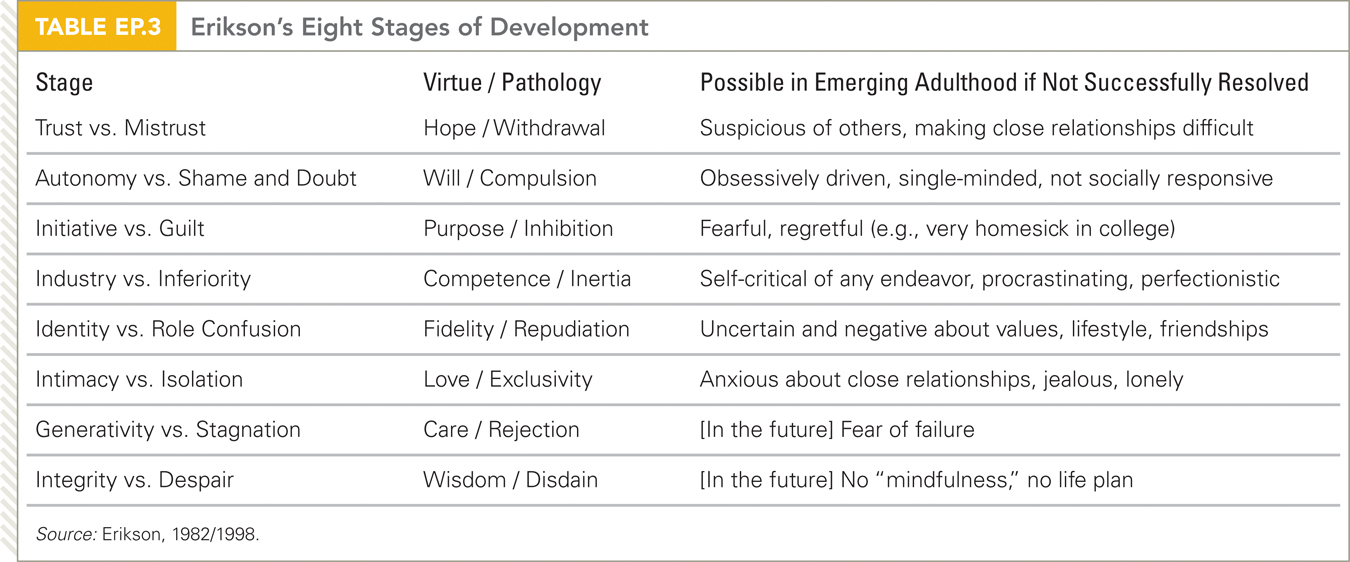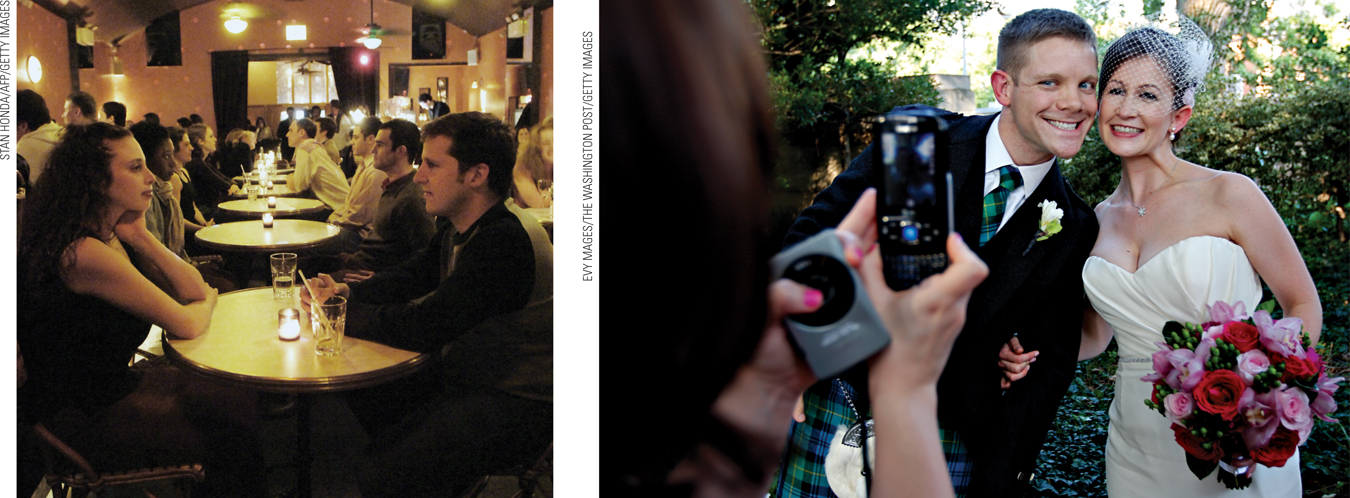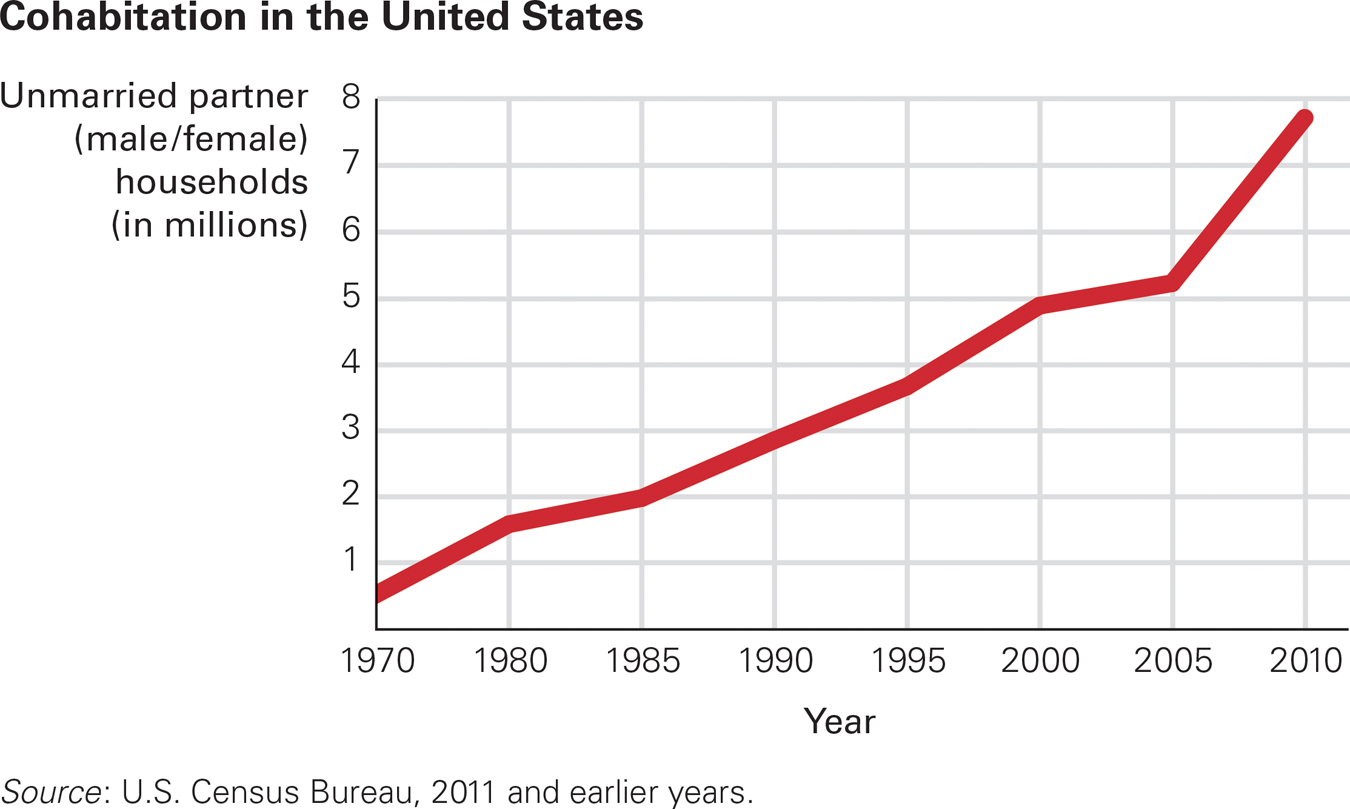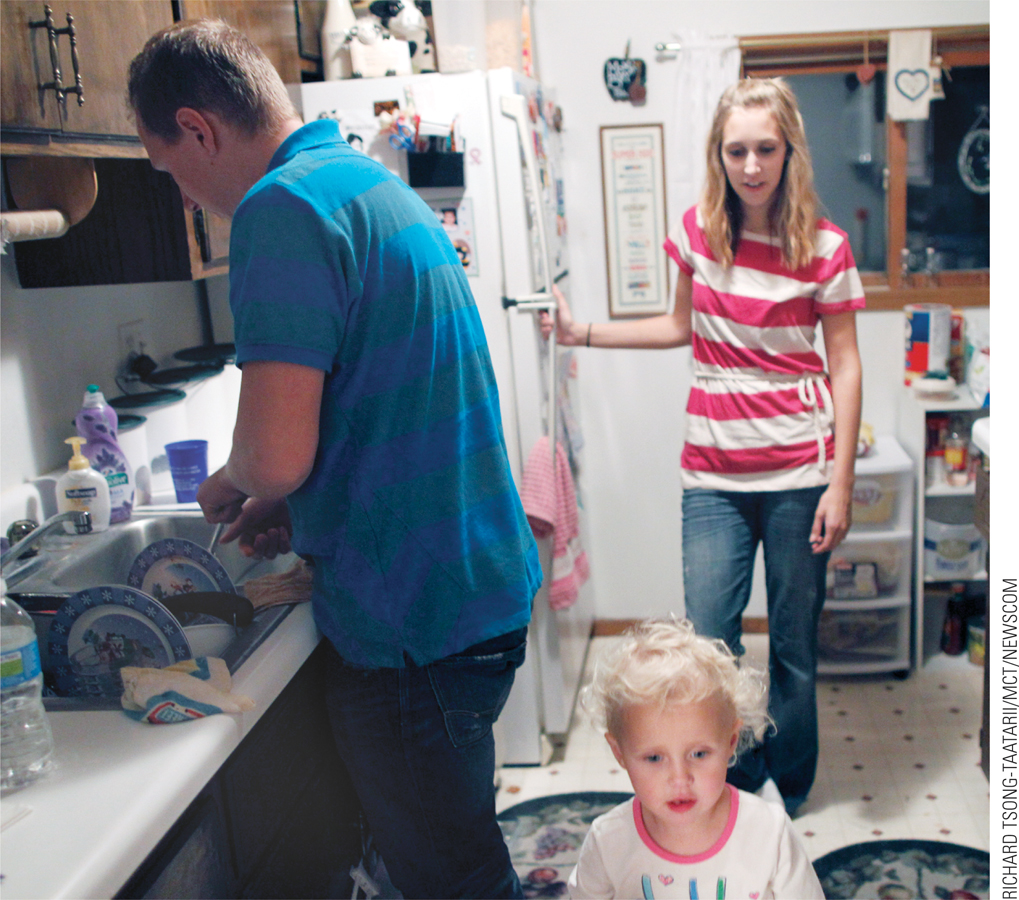Psychosocial Development
A theme of human development is that continuity and change are evident throughout life. In emerging adulthood, the legacy of early development is apparent amidst new achievements. Erikson recognized this ongoing process in his description of the fifth of his eight stages, identity versus role confusion. Remember that the crisis of identity versus role confusion begins in adolescence, but it is not usually resolved then.
Identity Achieved
As already mentioned, Erikson believed that the outcome of earlier crises provides the foundation for each new stage. The identity crisis is an example (see Table EP.3); adults of all ages continue to reflect on their identities.

Developmental psychologists, influenced by Erikson and emerging adults themselves, consider establishing a vocational identity to be part of growing up (Arnett, 2004). Emerging adulthood is a “critical stage for the acquisition of resources”—including the education, skills, and experience needed for vocational success (Tanner et al., 2009, p. 34).
Current emerging adults often quit one job and seek another. Between ages 18 and 25, the average U.S. worker changes jobs every year, with the college-
Young workers are not ready to climb a particular vocational ladder, rung by rung. That is a problem for employers, who must interview, choose, and train new employees (Meister, 2012). It is less problematic for the young adults themselves, since exploration is part of the identity search.
Emerging adulthood is a crucial time for developing values regarding work. Are job security and salary (extrinsic rewards) more important than the joy of doing the work one loves (intrinsic rewards)?
The economic recession, apparent worldwide beginning roughly in 2008, is likely to affect how those entering the job market develop their vocational identity (Johnson et al., 2012; Chow et al., 2014). For all emerging adults, the development of personal identity and a sense of purpose are likely to further vocational identity and result in a happier work life (Porfeli et al., 2013).

Personality in Emerging Adulthood
Continuity and change are evident in personality. Of course, temperament, childhood trauma, and emotional habits endure lifelong: If self-
Yet personality is not static. After adolescence, new characteristics appear and negative traits diminish. Emerging adults make choices that break with the past. This age period is now characterized by years of freedom from a settled lifestyle, which allows shifts in attitude and personality. Overall, a study with almost a million adolescents and adults from 62 nations found that “[d]uring early adulthood, individuals from different cultures across the world tend to become more agreeable, more conscientious, and less neurotic” (Bleidorn et al., 2013, p. 2530).
Rising Self-Esteem
Psychological research finds both continuity and improvement. For example, one longitudinal study found that 17-
This positive trend of increasing happiness has become more evident over recent decades, perhaps because young adults are more likely than adolescents to make their own life decisions and move past the role confusion at the beginning of the identity search (Schwartz et al., 2011).
Plasticity
Emerging adults are open to new experiences (a reflection of their adventuresome spirit), and this allows personality shifts as well as eagerness for more education (McAdams & Olson, 2010). Going to college, leaving home, paying one’s way, stopping drug abuse, moving to a new city, finding satisfying work and performing it well, making new friends, committing to a partner—
Total transformation does not occur since genes, childhood experiences, and family circumstances always affect people. Nor do new experiences always lead to improvement. Cohort effects are always possible: Perhaps the rising self-
Intimacy
In Erikson’s theory, after achieving identity, people experience the sixth crisis of development, intimacy versus isolation. This crisis arises from the powerful desire to share one’s personal life with someone else. Without intimacy, adults suffer from loneliness and isolation. Erikson (1963) explains:
The young adult, emerging from the search for and the insistence on identity, is eager and willing to fuse his identity with others. He is ready for intimacy, that is, the capacity to commit himself to concrete affiliations and partnerships and to develop the ethical strength to abide by such commitments, even though they call for significant sacrifices and compromises.
[p. 263]
The urge for social connection is a powerful human impulse, one reason our species has thrived. Other theorists use different words (affiliation, affection, interdependence, communion, belonging, love) for the same human need. Attachment experienced in infancy may well be a precursor to adult intimacy, especially if the person has developed a working model of attachment (Chow & Ruhl, 2014; Phillips et al., 2013). Adults seek to become friends, lovers, companions, and partners.
All intimate relationships (friendship, family ties, and romance) have much in common—
As Erikson (1963) explains, to establish intimacy, the emerging adult must
face the fear of ego loss in situations which call for self-
[pp. 163–
According to a more recent theory, an important aspect of close human connections is “self-
Romantic Partners
Love, romance, and commitment are still important for emerging adults, although specifics have changed. Most emerging adults are thought to be postponing, not abandoning, marriage. As one U.S. sociologist explains, “despite the culture of divorce, Americans remain optimistic about and even eager to enter marriages” (Hill, 2007, p. 295). One of the hottest political issues in 2014 in the United States was whether gay and lesbian couples can marry legally. The fact that people care deeply about this issue indicates that marriage is still considered desirable.
The relationship between love and marriage depends on era and culture. Three distinct patterns are evident.
In about one-
In another one-
The third pattern is relatively new, although familiar to most readers of this book. Young people socialize with hundreds of others and pair off but do not marry until they are able, financially and emotionally, to be independent. Their choices tilt toward personal qualities observable at the moment, such as physical appearance, personal hygiene, personality, sexuality, a sense of humor, not qualities more important to parents, such as religion, ethnicity, or long-
Suggesting “one-
For Western emerging adults, the third type is idealized. Love is considered a prerequisite for marriage and then sexual exclusiveness is expected, as found in a survey of 14,121 people of many ethnic groups and orientations (Meier et al., 2009). They were asked to rate from 1 to 10 the importance of money, same racial background, long-
Faithfulness to one’s partner was considered most important of all (rated 10 by 89 percent) and love was almost as high (rated 10 by 86 percent). By contrast, most thought being of the same race did not matter much (57 percent rated it 1, 2, or 3). Money, while important to many, was not nearly as crucial as love and fidelity.
This survey was conducted in North America, but emerging adults worldwide share many of the same values. Six thousand miles away, emerging adults in Kenya also reported that love was the primary reason for couples to connect and stay together; money was less important (S. Clark et al., 2010).
Finding Each Other
One major innovation of the current cohort of emerging adults is the use of social networks. Web sites such as Facebook and Instagram allow individuals to post their photos and personal information on the Internet, sharing the details of their daily lives with thousands of others. College students almost all (93 percent) use social media sites, particularly to connect with each other (Chronicle of Higher Education, 2014). Many also use Internet matching sites to find potential partners.

One problem is that social networking may produce dozens of potential partners, increasing choice overload when too many options are available. Choice overload increases second thoughts after a choice is made. (People wonder whether they would have been happier with another choice.) Some people, overloaded with possibilities, refuse to make any selection (Iyengar & Lepper, 2000; Reutskaja & Hogarth, 2009).
Choice overload has been demonstrated with consumer goods—
Living Together
A second major innovation among emerging adults is cohabitation, the term for living together in a romantic partnership without being married. Cohabitation varies widely from one generation and one nation to another.
Two-

More Together, Fewer Married As you see, the number of cohabitating male–
Research from 30 nations finds that acceptance of cohabitation within their nation affects the happiness of those who cohabit. Demographic differences within those 30 nations (such as education, income, age, and religion among both the married and cohabiting couples) affect happiness as well (Soons & Kalmijn, 2009).
In the United States, cohabiting couples have higher rates of breakups than married couples. Furthermore, children born to cohabiting couples are more likely to have academic, health, or emotional difficulties (Schmeer, 2011). Although there are practical reasons for cohabitation—
On the other hand, it is not proven that, for contemporary couples, cohabitation is harmful. Some factors—
Emerging Adults and Their Parents
It is hard to overestimate the importance of the family during any period of the life span. Although a family is made up of individuals, it is much more than the persons who belong to it. In the dynamic synergy of a well-

If anything, parents today are more important to emerging adults than ever. Two experts in human development write: “[W]ith delays in marriage, more Americans choosing to remain single, and high divorce rates, a tie to a parent may be the most important bond in a young adult’s life” (Fingerman & Furstenberg, 2012).
All members of each family have linked lives; that is, the experiences and needs of each family member at one stage of life are affected by every other family member (Elder, 1998; Macmillan & Copher, 2005). We have seen this in earlier chapters: Children are affected by their parents’ relationship, even if the children are not directly involved in their parents’ domestic disputes, financial stresses, parental alliances, and so on. Brothers and sisters can be abusers or protectors, role models for good or for ill.
Many emerging adults still live at home, though the percentage varies from nation to nation. Almost all unmarried young adults in Italy and Japan live with their parents. Fewer do so in the United States, but many parents underwrite their young-
There is a downside to parental support: It may impede independence. The most dramatic example is the so-

All Together Now
When we look at actual lives, not the cultural ideal of independence or interdependence, emerging adults worldwide have much in common, including close family connections and a new freedom from parental limits. Family members continue to feel obligated to one another no matter where they live or how old they are.
On the first page of Chapter 1, you learned that the science of human development is about how people change over time and that change is ongoing, with variations by culture, family, SES, and history. Every chapter describes potential problems as well as strategies that help most individuals survive and thrive.
This chapter began by explaining that emerging adulthood provides a review and a preview. Both are now apparent: Most 18-
SUMMING UP Patterns of psychosocial development in emerging adulthood evidence continuity and change. Personality traits endure, but improvement is often apparent as young adults experience rising self-
WHAT HAVE YOU LEARNED?
Question 17.14
Why is vocational identity particularly elusive in current times?
The economic recession, apparent worldwide beginning roughly in 2008, is likely to affect how those entering the job market develop their vocational identity. Specifically, vocational identity is particularly difficult in today's job market, with emerging adults likely to change jobs often.Question 17.15
How does personality change from adolescence to adulthood?
After adolescence, new characteristics appear and negative traits diminish. Emerging adults make choices that break with the past. This age period is now characterized by years of freedom from a settled lifestyle, which allows shifts in attitude and personality. Overall, a study with almost a million adolescents and adults from 62 nations found that “during early adulthood, individuals from different cultures across the world tend to become more agreeable, more conscientious, and less neurotic.”Question 17.16
What do emerging adults seek in a close relationship?
Love, romance, and commitment in relationships are important to emerging adults.Question 17.17
How has the process of mate selection changed over the past decades?
A more recent pattern of finding romantic partners focuses on personal qualities that are observable at the moment, such as physical appearance, personal hygiene, personality, sexuality, a sense of humor, not qualities more important to parents, such as religion, ethnicity, or long–term stability. In addition, emerging adults are increasingly turning to social media sites to find potential partners. Question 17.18
Why do many emerging adults cohabit instead of marrying?
Many couples cohabit in order to “test out” compatibility for marriage. Other reasons include saving money and postponing the commitment of marriage.Question 17.19
What kinds of support do parents provide their young-
adult children? Many emerging adults still live at home, though the percentage varies from nation to nation. In addition, a large percentage of parents underwrite their young adult children's independent living if they can afford to do so. When they do not live at home, emerging adults see their parents, on average, several times a week and phone them even more often.